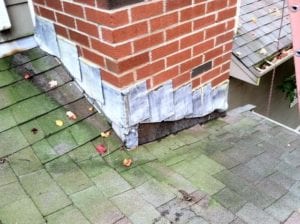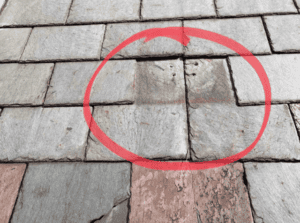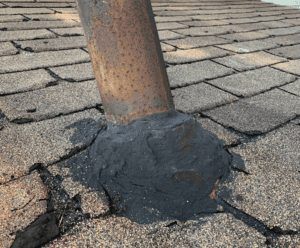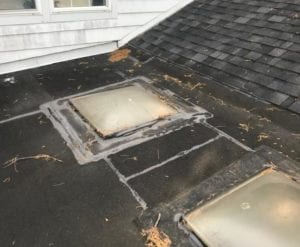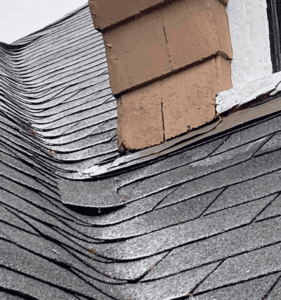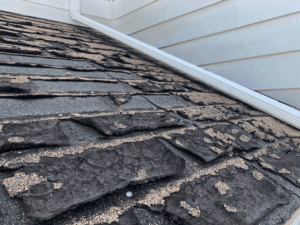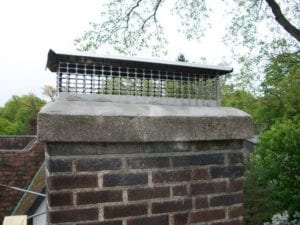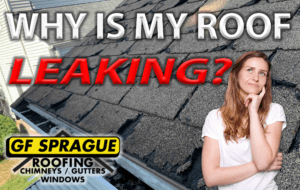
One of the biggest threats to your home and safety is a leak in your roof. Figuring out the cause of a leak will save you the time and money spent to repair long-term structural damage. If you act quickly enough most roofs can be saved with a repair rather than needing a full replacement. Because your roofing system has many parts and functions, you must educate yourself on every piece of the roofing puzzle to prevent these issues from happening in the future. Below are the ten most common causes of roof leaks and how you can fix them.
Did you know? Roof leaks not only damage your interior ceiling and walls but cause black mold to grow and threaten your family’s health.
1. Your Flashing is Damaged
-
What is it?
- Flashing is a piece of metal, usually aluminum or copper, that works as a barrier to prevent water or debris from entering the home through crevices behind your gutters or around your chimney. When your flashing is cracked, aged, or torn off by heavy winds, that protective barrier can no longer do its job and your home is now vulnerable to the elements.
-
How does it happen?
- Your flashing can be damaged by a multitude of factors. Here are the top causes of damaged flashing that can cause leaks.
-
Age:
- Over time, the tar and caulking that seal flashing to the roof can dry and crack, causing the flashing to unseal and slip out of place. Also, cheaper materials used to flash your chimney or gutters can corrode over time and lose their structure.
-
Harsh Weather Conditions
- During a storm, your roof is an easy target for wind, rain, and debris. In a worst-case scenario, the uplift from wind, a falling tree limb, or heavy rainfall can weaken your flashing enough for it to lose it’s hold and/or crack. In these situations, be sure to call your local roofing company to have them inspect your roof after the storm. To learn more about the steps you should take after a storm, click here.
-
Improper Installation
- Flashing that is improperly installed can no doubt lead to premature damage. Using the right materials and properly nailing the flashing to the roof ensures it’s long-lasting durability without any room for error. If installed without taking these necessary steps, the flashing will be more likely to detach if affected by wind or rain.
-
- Your flashing can be damaged by a multitude of factors. Here are the top causes of damaged flashing that can cause leaks.
-
How to fix it?
- Now that you know the many causes of damaged flashing, how does one fix it? The first step is deciding whether or not the damage is severe enough to warrant emergency repairs. Your local roofing company will most likely offer an inspection and repair within the next week. If you are interested in fixing it yourself, here is what our roofing expert has to say:
2. You Have Ice Dam Build-up
-
What is it?
- If you see snow and ice build up on the top of your gutters, then you have an ice dam. A properly functioning roofing system works to prevent damage from ice dams. If, for instance, your attic is poorly ventilated and running hot, then snow on its surface will melt and then freeze on the edges which have a colder temperature. Ice dams also occur during freeze-thaw cycles when the snow melts during the day, builds up on the edge of your roof, and then freezes. Causes and Risks of Ice Dams.
-
How does it happen?
- When an ice dam freezes at the edge of your roof it causes the water above it on warmer surfaces to find cracks and openings in your roof. Water then enters your attic space and flows into surrounding areas like your walls or ceiling insulation.
-
How to fix it?
- A roofing expert can easily diagnose the root cause of the ice dam, but if you are looking to mitigate the symptom, then investing in a roof rake may be your solution.
3. Missing Shingles, Slates, Wood Shakes, or Tiles
-
What is it?
- These are the building materials used to cover your roof. As an essential part of the roofing system, if you miss one or more shingles, slates, wood shakes, or tiles, you are at a greater risk of leaks. While there are multiple barriers between your attic and the natural world, these act as the strongest defense against rain and debris.
-
How does it happen?
- Missing shingles or wood shakes often end up on your lawn and after a wind, snow or rainstorm. Broken tiles, including slate, often occur after large or heavy debris lands on the roof. Both missing and broken shingles or slates are a high risk of water intrusion into your home.
-
How to fix it?
- If you’re looking to DIY this project, be warned because it is dangerous and intricate. Here is a tip from one of our roofing experts on replacing shingles.
4. Cracked Roof Vents
-
What is it?
- Roof vents are pipes or boxes that protrude from the roof and work to expel excess moisture from inside the house. Around the vents are a rubber “vent boot” that works similar to flashing and provides a barrier between the junction of roof and pipe. These boots can be made of plastic, rubber, metal, or any combination.
-
How does it happen?
- Leaks caused by roof vents are often due to a crack in the roof vent boot from decay or debris.
-
How to fix it?
- Fixing a roof vent boot is an easier task than much other roofing work, and can be done by removing the cracked rubber vent boot with a knife. Then use a pry bar to unseal any connected shingles and slide the new vent boot under those shingles and on top of the roof vent. After, secure the new boot with roofing nails and caulk underneath the shingles to seal them to the new flashing.
5. Clogged Gutters
-
What is it?
- When your gutters become filled with leaves, pine needles, sticks, and other debris, it doesn’t properly distribute water out of the gutters and that water will end up in your home. Whether you have aluminum, copper, vinyl, or freedom gray gutters, gutter clogging is inevitable.
-
How does it happen?
- Gutters and downspouts work to guide water away from your home’s siding to prevent leaks into the walls and ceilings and the pooling of water around the base. If clogged, water in the gutters will begin to overflow out of the gutters and around the side of your home. Then, the pooling of water can enter your siding or basement and cause leaks and flooding.
-
How to fix it?
- The best prevention of clogged gutters is for you or your local roofing company to give your gutters a regular checkup. This means getting up on a ladder and using your hands to remove any debris blocking your gutters from doing their job.
Did you know? Clean your gutters in the fall and spring to keep them happy and flowing!
6. Skylight Issues
-
What is it?
- Skylights offer a wide range of benefits to the beauty and light inside your home, but also come with needed maintenance to protect your home from water damage.
-
How does it happen?
- If skylights are improperly installed or have damaged flashing, then water is likely to enter your home and appear as water stains around the skylight. Skylights need to be properly measured before installing, and not doing so will lead to crevices that are an easy entry point for water.
-
How to fix it?
- Because of this problem’s extent, it is recommended that you call a roofing expert to diagnose the cause. But if you are looking to do it yourself, be sure to safely clear off any debris around the skylight and check for cracks along its rubber membrane.
7. Unsealed Valleys
-
What is it?
- Valleys are the point at which two planes of your roof connect. Unlike the ridge which is the peak of your roof, valleys act as a cross point and lead collected water towards your gutters and downspouts.
-
How does it happen?
- In some cases, leaks from valleys are caused by erosion from rainwater, but it is often the case that valleys have been improperly sealed and rainwater hits that hotspot area and causes a leak.
-
How to fix it?
- This job, because of its complexity, is better done by a roofing expert. They will often add a leak barrier and consider whether your roof may need a metal valley to protect your home going forward. After doing so, they will install shingles around the new valley and properly seal the job.
8. Condensation in the attic
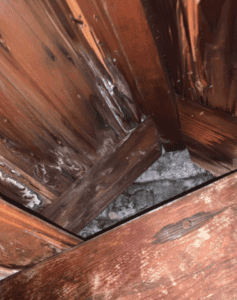
-
What is it?
- If you smell something musty in your attic then it’s likely you have mold or mildew growth. Not only that but if you see physical signs of mold, then you have water entry through your roof.
-
How does it happen?
- There are many causes of condensation in your attic, but one of the top reasons is improper ventilation. Roof vents work to expel added moisture and keep your attic at a proper temperature. Fluctuations in temperature or extreme heat or cold can cause moisture to grow in your attic space and lead to leaks or dangerous mold growth.
-
How to fix it?
- The first step is to treat the mold growth. You and your family’s health and safety is the priority. Then you will need a roofing expert to diagnose the cause of the excess moisture. It could be from many sources and they will make sure to find the root cause of the problem.
9. Age
-
What is it?
- This one is pretty self-explanatory. When your roof is old it will have years worth of erosion and storm damage that will undoubtedly lead to water and structural damage.
-
How does it happen?
- Harsh weather and sunlight can lead to the deterioration of your roof. Roofing material becomes brittle and cracks over time in addition to sunlight melting the tar that seals your shingles together.
-
How to fix it?
- Now’s the time to replace your roof. This is the point at which you need to invest in a new roof to protect your home from further damage. Your local roofing companies will provide different quotes and assessments that you can choose between for what fits your budget and needs.
10. You Have a Cracked Chimney
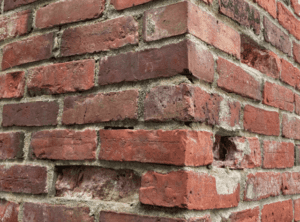
-
What is it?
- Your chimney is often one of the leading causes of water leaks because of the many edges and crevices involved in its structure. The mortar used to keep the bricks together erodes over time and can create new holes for water to seep into.
-
How does it happen?
- Within your chimney are various parts that allow it to function and repel water or debris. That includes flashing, mortar, chimney cap, and chimney crown. When one of those parts deteriorate, crack, or unseal, you leave your home vulnerable to the elements.
-
Flashing
- If your chimney flashing is improperly installed or cracked, the water can enter your home through your chimney in the very crevices that the flashing works to cover.
-
Mortar
- The mortar is the glue to keep your chimney together. If the mortar erodes or is damaged, then not only water can enter through those cracks, but the actual bricks could fall out.
-
Chimney Cap

- Your chimney cap sits on top of the chimney and protects it from debris or animals entering your home. When this essential piece of your chimney is missing, then damage from creatures or the elements can affect your chimney’s structure.
-
Chimney Crown
- The chimney crown is often cement or metal that lines the top of your chimney to prevent water from entering its structure. When the chimney crown erodes or cracks, water can flow through the bricks into your walls or ceilings and cause leaks.
-
- Within your chimney are various parts that allow it to function and repel water or debris. That includes flashing, mortar, chimney cap, and chimney crown. When one of those parts deteriorate, crack, or unseal, you leave your home vulnerable to the elements.
-
How to fix it?
- With many factors causing a leak from your chimney, you must contact a local roofing company to take care of this issue. Chimney work is a dangerous task and you are better safe than sorry on this one. They will properly diagnose the cause of the leak and carefully repair the issue.
If you are reading this because you are attempting to repair the leak yourself, we recommend that you first reach out to a local roofing company because the risks outweigh the benefits. Exterior restoration is a very dangerous job and not something that homeowners should take lightly. We hope this article helps educate you on your roof’s various aspects and how it will and can be repaired from damage.
Related Articles:
Which Roofing Material is Best?
